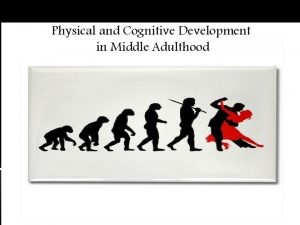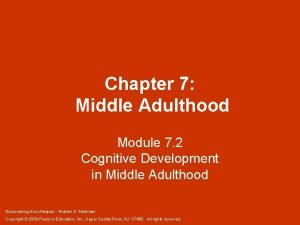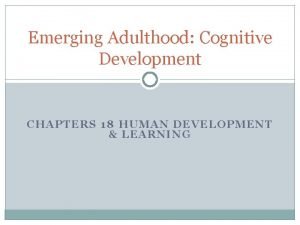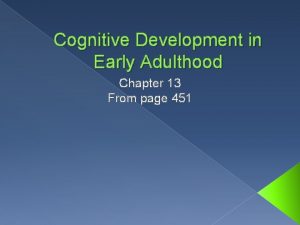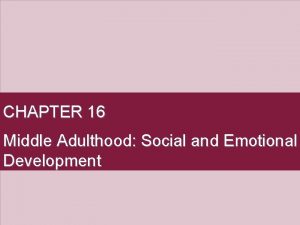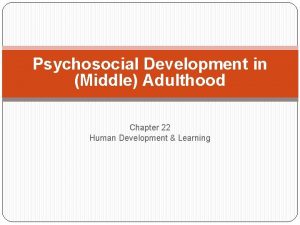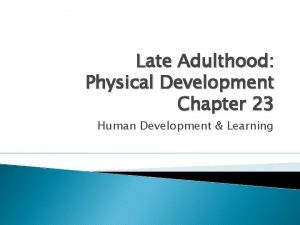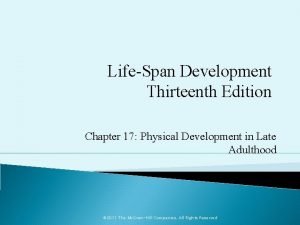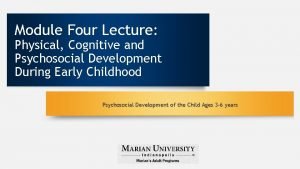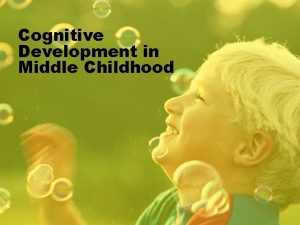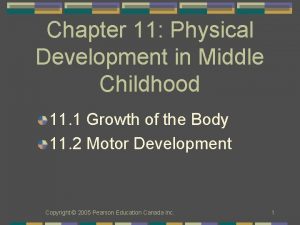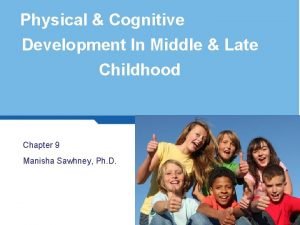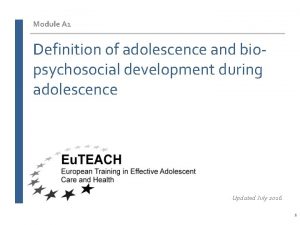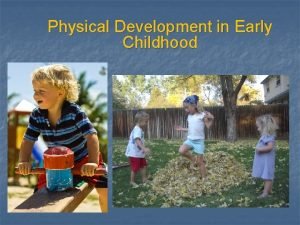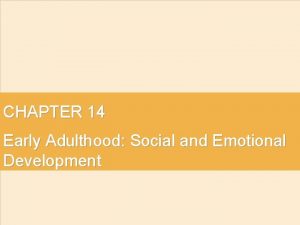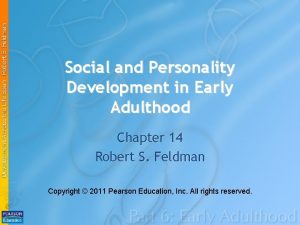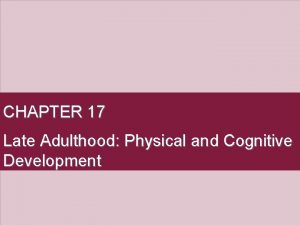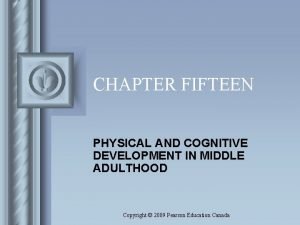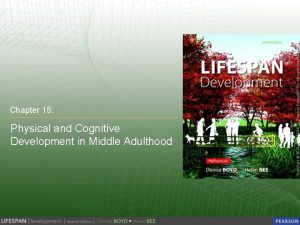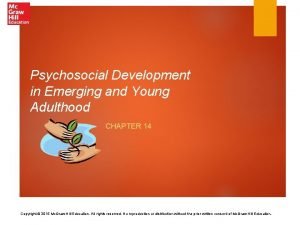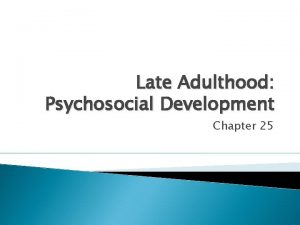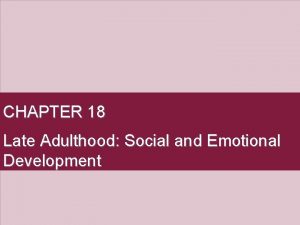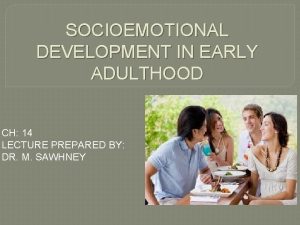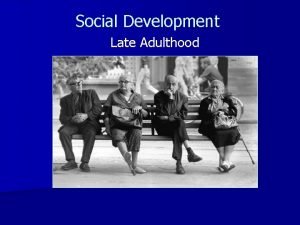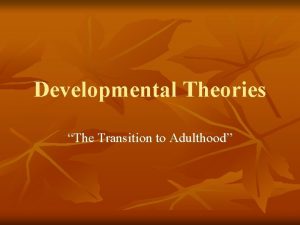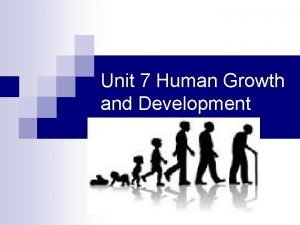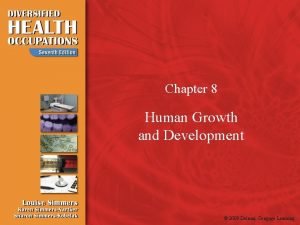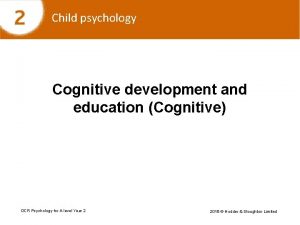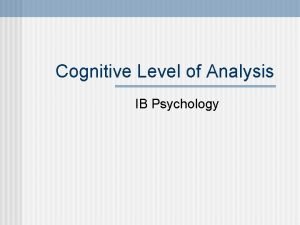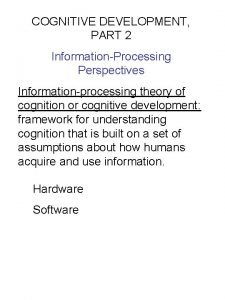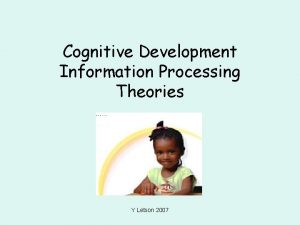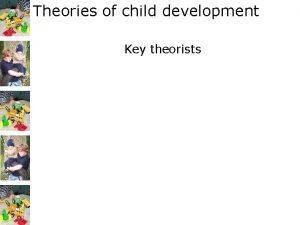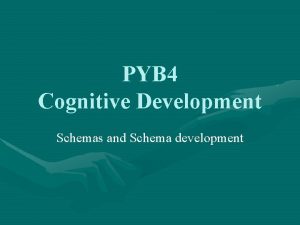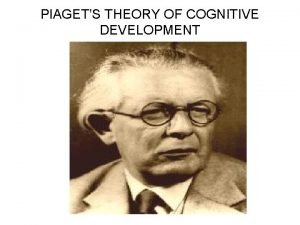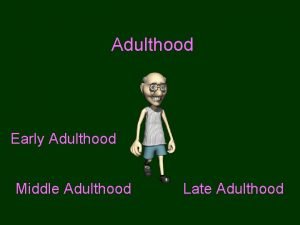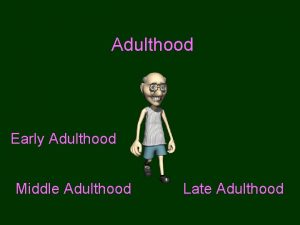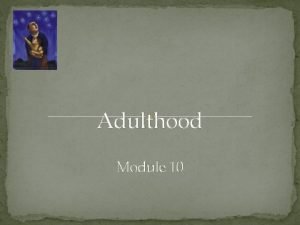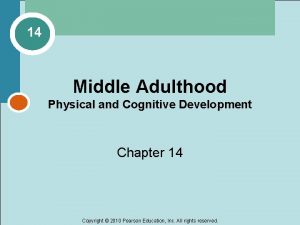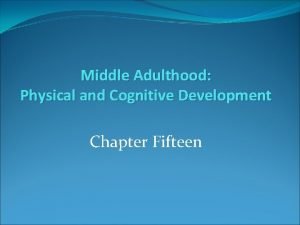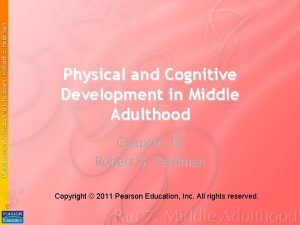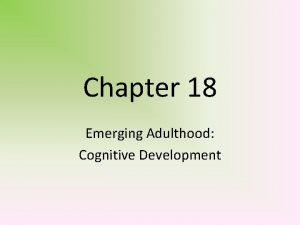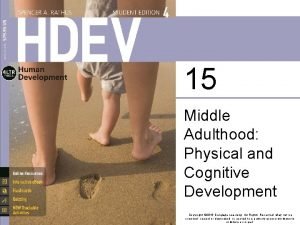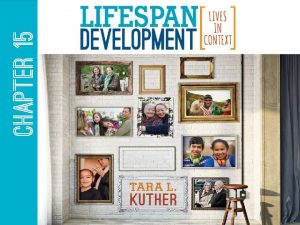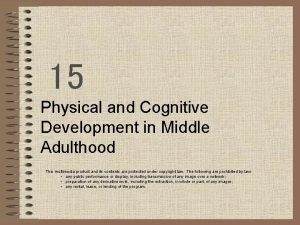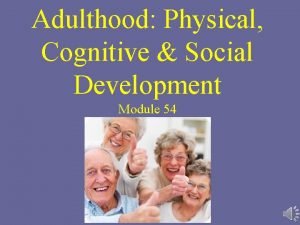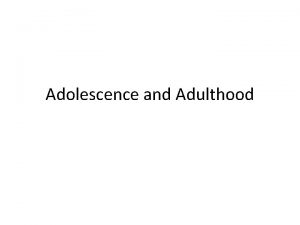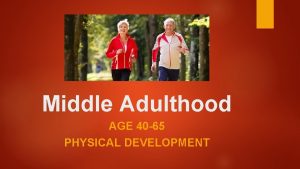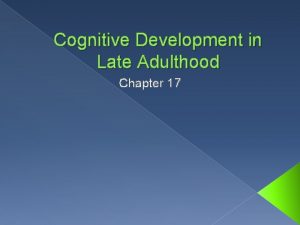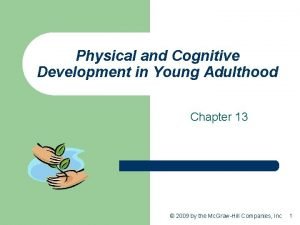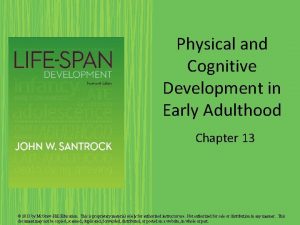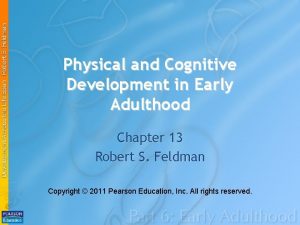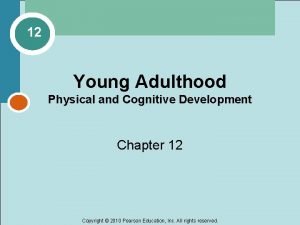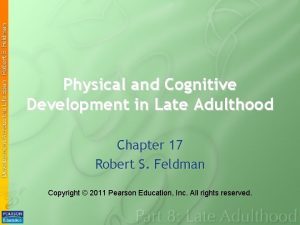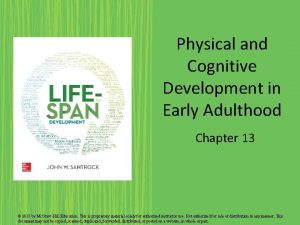CHAPTER 15 Middle Adulthood Physical and Cognitive Development






















































- Slides: 54

CHAPTER 15 Middle Adulthood: Physical and Cognitive Development

Physical Development

When Are We Middle-Aged? • Developmentalists consider middle adulthood to span the years from 40 to 60 or 65. – The years between 60 to 65 serve as transition years into late adulthood. • Cognitive development is at its peak during middle adulthood. – Any lapse is oftentimes made up in expertise

Physical Development • Interindividual variability – No two people age in the same way or at the same rate • Physiological aging – Changes in the body’s integumentary system, senses, reaction time, and lung capacity • Changes in metabolism, muscle mass, strength, bone density, aerobic capacity, blood-sugar tolerance, and ability to regulate body temperature may be moderated or reversed through exercise and diet.

Skin and Hair • Gray hair occurs due to the decrease of melanin. – Hair loss accelerates, especially in men • Skin becomes dryer and more brittle due to fewer keratinocytes being produced. • Genetics, diet, hormonal balances, and exposure to sun (especially to UV rays) all play a part in wrinkling. • Wrinkling due to exposure to UV rays is called photo aging.

Sensory Functioning • Changes in vision occur mid-30’s • Presbyopia – Loss of elasticity in the lens that makes it harder to focus on, or accommodate to, nearby objects or fine print; result is middle adults may need reading glasses

Reaction Time • Reaction time – Amount of time it takes to respond to a stimulus – Increases with age beginning around age 25

Lung Capacity • Lung tissue stiffens with age – Diminishing capacity to expand, such that breathing capacity may decline by half between early adulthood and late adulthood – Regular exercise can offset this loss – First beginning to exercise in middle adulthood can expand breathing capacity beyond what it was earlier in life

Lean-Body Mass and Body Fat • Lean-body mass, especially muscle, declines with age. • Rate of loss accelerates after age 45 – Fat replaces lean-body mass

Muscle Strength • Loss of muscle lessens strength – Change is gradual – Exercise can compensate by increasing the size of remaining muscle cells • Exercise will contribute to vigor, health, and a desirable body shape.

Metabolism • Metabolism – Rate at which the body processes or “burns” food to produce energy • Resting metabolic rate – Also called basal metabolic rate (BMR) declines with age • BMR drops by about 2% per decade beginning at age 20 • Middle-aged people likely to gain weight if they eat like they did when they were younger – Exercise helps control the weight gain

Bone Density • Bones begin to lose density at around the age of 40. – As bones lose density, they become more brittle and prone to fracture • Bones in the spine, hip, thigh, and forearm lose the most density as we age.

Aerobic Capacity • Cardiovascular system becomes less efficient as we age – Heart and lung muscles shrink • Maximum heart rate declines, but exercise expands aerobic capacity at any age

Blood-Sugar Tolerance • As we age, tissues in the body become less capable of taking up glucose from the bloodstream. • Body tissues lose sensitivity to insulin, thus blood-sugar levels rise, increasing the risk of adult-onset diabetes. • Adults can minimize this condition by controlling their weight, eating less fat, and exercising regularly.

Health

Health • Health of people aged 40 -65 in developed nations is better than it has ever been. • Ways to increase health during middle adulthood – – – Regular medical checkups Paying attention to diet Exercising, avoiding smoking, drinking in moderation if at all Regulating stress Having supportive relationships

Leading Causes of Death • Leading causes of death during middle adulthood are cancer, heart disease, and accidents • Screening for prostate cancer, breast cancer, and cancer of the colon and rectum is necessary during middle adulthood. • Recommended that African-American men get screened for prostate cancer at age 45 • Women recommended to get mammograms at age 40 • Screening for colorectal cancer recommended for both men and women at age 50; EKG at age 50 as well

Cancer • In many instances, cancer can be controlled or cured if caught early. • Cancer is a chronic, noncommunicable disease characterized by uncontrolled growth of cells. – – Tumors can be benign (noncancerous) or malignant (cancerous) Benign typically do not pose a threat to life Malignant tumors invade and destroy surrounding tissue Cancerous cells in malignant tumors can break away from primary tumor, travel through the bloodstream to form new tumors, called metastases

Cancer (cont’d) • Internal factors – such as heredity, problems in the immune system, and hormonal factors can contribute to mutations in the DNA • External factors – Carcinogens – Include some viruses, chemical compounds in tobacco and elsewhere, and ultraviolet solar radiation • Incidence of cancer almost triples in the decade of 55 to 64 years of age as compared to the previous decade – Three-fourths of cancer occur in people age 55 and older

Cancer (cont’d) • African Americans have higher than average colon and rectal cancer death rates and incidence rates. • African Americans have twice the death rates from prostate cancer. • Incidence of cervical cancer highest in Latina American women • American Indian and Alaska natives have lowest survival from all cancers combined • Lack of health insurance contributes to late diagnosis

Cancer (cont’d) • Cigarette smoking and high-fat diet contribute to cancer • Second-hand smoke contributes to cancer deaths. • Treatment consists of surgery, radiation, chemotherapy, and hormonal therapy – Limitation of treatment is anticancer drugs kill healthy tissue as well as diseased tissue

Figure 15 -2 p 315

• Lifetime Risk of Developing Cancer

Heart Disease • Heart disease – Second leading cause of death in middle adulthood – Leading cause of death in late adulthood • Heart disease is due to insufficient flow of blood to the heart – Most commonly results from arteriosclerosis (hardening of the arteries) – Arteriosclerosis can impair circulation and increase the risk of a blood clot, choking off the flow of blood and resulting in a heart attack or stroke – Most common form called atherosclerosis (buildup of fatty deposits call plaque; arteries narrow)

• Atherosclerosis Figure 15 -3 p 317

Heart Disease (cont’d) • Age, race/ethnicity, and sex are risk factors. • No smoking, exercise, good diet, and in some cases medication can help minimize risks. • Getting blood pressure and cholesterol levels measured can help identify heart health issues. • On average, African Americans have higher risk of high blood pressure; may contribute to dying from heart disease due to hypertension

Figure 15 -4 p 317

The Immune System

The Immune System • Immune system is the body’s defense against infections and other sources of disease • Immune system combats disease by the production of white blood cells (leukocytes) and by inflammation

Stress and the Immune System • Stress – Suppresses the immune system by stimulating the production of steroids, which decrease inflammation and interfere with the formation of antibodies resulting in more susceptibility to disease – Stress related to rapid progression of HIV infection to AIDS • Stress hormones associated with anger may contribute to heart attack. • High-strain work puts workers at the highest risk. • Stress may be linked to the increase in cancer incidence, higher cholesterol levels, and a greater risk of heart disease

Sexuality

Sexuality • Most people in middle adulthood lead rich sex lives. • Gradual decline in the frequency of sex – Women aged 50 -59 highest group not having sex • Most common problem of women is – lack of sexual desire and difficulty becoming sexually aroused • Most common problem of men is – erectile dysfunction • Incidence of problems increase with age

• Frequency of Sex in the Past 12 Months

Menopause, Perimenopause, and the Climacteric • Menopause – – Cessation of menstruation Normal process occurring between ages of 46 and 50 Lasts about 2 years Can begin any time between 35 and 60 • Perimenopause – Beginning of menopause characterized by 3 to 11 months of amenorrhea (lack of menstruation) – Deficit in estrogen may result in hot flashes alternating with cold sweats • Climacteric (critical period) – Refers to gradual decline in the reproductive activity of the ovaries – Menstrual cycles become more erratic

Menopause, Perimenopause, and the Climacteric (cont’d) • Some women feel sexually liberated following menopause due to separation of sex and reproduction • Menopausal women may have sleep issues. • Estrogen deficiency has psychological effects. – Long-term estrogen deficiency has been linked to brittleness and porosity of the bones • Osteoporosis – Bones break easily – May result in serious fractures, can be life threatening

Hormone Replacement Therapy • Hormone replacement therapy (HRT) – Effective for some women – Results of safety of use are inconclusive – Some women increase risk of breast cancer, strokes, and blood clots due to exposure to a combination of estrogen and progestin • Selective serotonin reuptake inhibitors (SSRIs) help with menopause.

Sexual Dysfunctions • Sexual dysfunctions – Persistent or recurrent problems in becoming sexually aroused or reaching orgasm • Women report – more painful sex, lack of pleasure, inability to reach orgasm, and lack of desire • Men more likely to report – reaching orgasm too soon (“premature ejaculation”), which is more common in early adulthood – lack of interest in sex and erectile dysfunction (more common in men in middle adulthood)

Sexual Dysfunctions (cont’d) • Lack of desire usually limited to one partner – Sex therapists recommend trying to compromise and/or resolving problems that may be affecting their sexual relationship • Erectile dysfunction – Characterized by persistent difficulty in achieving or maintaining an erection sufficient to allow the completion of sexual activity – Incidence increases with age – Makes men anxious when sexual opportunity arises because they expect failure instead of pleasure – As a result, sex may be avoided – Partner may be frustrated as well

Sexual Dysfunctions (cont’d) • Reduction in testosterone levels as well as medication may be contributing factor to lack of sexual desire in men • Medical conditions that affect sexual response include – heart disease, diabetes, multiple sclerosis, spinal-cord injuries, complications from surgery, hormonal problems, medications for hypertension, and mental disorders • Erectile problems can arise when clogged or narrow arteries leading to the penis deprive the penis of oxygen.

Sexual Dysfunctions (cont’d) • Perimenopausal and postmenopausal women usually – produce less vaginal lubrication than younger women, and the vaginal walls thin, changes which can cause sex to be painful – artificial lubrication can help supplement the woman’s own production • Physical changes can produce performance anxiety and discourage both partners from sexual relations. • Exercise appears to ward off erectile dysfunction. – Medications such as Viagra help • The sexual relationship is usually representative of other facets of the relationship.

Cognitive Development

Cognitive Development • Verbal ability maintains stability as we age. • Timed performance decreases as we age.

Changes in Intellectual Abilities • Intellectual development during middle adulthood demonstrates multidirectionality, interindividual variability, and plasticity. • Multidirectionality – Some aspects of intellectual functioning improves while others remain stable or decline. • Interindividual variability – People mature differently due to different cultural and social settings. • Plasticity – Intellectual abilities are not fixed but can be modified under certain conditions at almost any time in life.

Cohort Effects • Research conducted by Schaie (Charness & Schaie, 2003) indicates – intellectual functioning of the members of a society reflects the technology and social functioning of that society. – people in one cohort will perform better or worse in particular areas than people who are from a different age cohort.

Fig. 15 -5, p. 322

Crystallized Intelligence versus Fluid Intelligence • Crystallized intelligence – Cluster of knowledge and skills that depend on accumulated information and experience, awareness of social conventions, and the capacity to make good decisions and judgments – Includes specialized knowledge in a field – Increases with age • Fluid intelligence – Person’s skills at processing information – Refers to the speed of processing or analyzing information, the ability to comprehend the relationships in visual stimuli – Decreases with age

Crystallized Intelligence versus Fluid Intelligence (cont’d) • Conditions minimizing cognitive decline may include – remaining healthy – living in good conditions, such as decent housing – remaining intellectually active by reading, lifelong learning, and keeping up with current events – being open to new ideas and new styles of life – living with an intellectually stimulating partner – being satisfied with what one has achieved in middle adulthood or one’s most productive years

Information Processing: Speed of Information Processing • Information processing can be measured in reaction time – The amount of time it takes to respond to a stimulus – People in middle adulthood have greater reaction time • (Meaning slower) than young adults – Only a fraction of a second • Decline in speed may be due to changes in the integrity of the nervous system – Scientific research is inconclusive

Memory • Most researchers conclude that people in middle and late adulthood perform less well than young adults at – memorizing lists of words, numbers, or passages – rote rehearsal • Less able to keep information in working memory long enough to memorize it as we age • Less capable of screening out distractions as we try to focus on material as we age • Elaborative rehearsal suffers as well because we are less capable of classifying or categorizing quickly

Memory (cont’d) • General knowledge is expanded during middle adulthood due to interest in new areas. • Procedural memory such as riding a bike or driving a car can be maintained for a lifetime.

Expertise and Practical Problem Solving • Expertise and practical problem solving increases with age. – due to social, emotional, professional experience • Hiring a person in middle adulthood is beneficial. – due to their greater store of expertise and practical problem solving skills • Once again, there is interindividual variation

Creativity and Learning

Creativity • Many people at their height of creativity during middle adulthood • Difference in creativity in age can be found in creativity in – music, mathematics, and physics, with young adults surpassing people in middle adulthood • Writers and visual artists continue to improve into middle adulthood, most emotional work tends to be at a younger age

Mature Learners • Learning possibilities affected by culture, social structure, desire to learn • Mature learners – are highly motivated and more likely than younger learners to find the subject interesting for its own sake (great interindividuation in learning) • Women with the greatest demands on them from family and work are most likely to return to school. – Need emotional and professional support
 Early adulthood cognitive development
Early adulthood cognitive development Physical and cognitive development in early adulthood
Physical and cognitive development in early adulthood Intellectual development in middle adulthood
Intellectual development in middle adulthood Cognitive development in middle adulthood
Cognitive development in middle adulthood Middle adulthood physical development
Middle adulthood physical development Developmental milestones 40-65 years
Developmental milestones 40-65 years Late adulthood mental development
Late adulthood mental development Postformal thought
Postformal thought Cognitive changes in early adulthood
Cognitive changes in early adulthood Social and emotional development in middle adulthood
Social and emotional development in middle adulthood Middle adulthood social changes
Middle adulthood social changes Middle adulthood psychosocial development
Middle adulthood psychosocial development Social development in adulthood
Social development in adulthood Cognitive development of late childhood
Cognitive development of late childhood Late adulthood physical changes
Late adulthood physical changes Physical changes in late adulthood
Physical changes in late adulthood Fraction definition
Fraction definition Define physical cognitive and psychosocial development
Define physical cognitive and psychosocial development Cognitive development in middle childhood
Cognitive development in middle childhood Physical development in middle childhood chapter 11
Physical development in middle childhood chapter 11 Cognitive and non cognitive religious language
Cognitive and non cognitive religious language Late childhood
Late childhood Chapter 5 cognitive development in infancy and toddlerhood
Chapter 5 cognitive development in infancy and toddlerhood Middle adolescence physical development
Middle adolescence physical development Physical development in middle childhood
Physical development in middle childhood Physical development in middle childhood
Physical development in middle childhood Stages of growth and development from infancy to adulthood
Stages of growth and development from infancy to adulthood Social development in early adulthood
Social development in early adulthood Social and personality development in early adulthood
Social and personality development in early adulthood Social and emotional development in late adulthood
Social and emotional development in late adulthood Early childhood is ____ for language learning
Early childhood is ____ for language learning Physical changes in late adulthood
Physical changes in late adulthood Denny's model of physical and cognitive ageing
Denny's model of physical and cognitive ageing Denny's model of physical and cognitive ageing
Denny's model of physical and cognitive ageing Emerging adulthood psychosocial development
Emerging adulthood psychosocial development Psychosocial development in late adulthood
Psychosocial development in late adulthood Peck's developmental tasks
Peck's developmental tasks Early adulthood socioemotional development
Early adulthood socioemotional development Disengagement theory
Disengagement theory Klaus riegel theory
Klaus riegel theory Unit 7:3 human needs
Unit 7:3 human needs Emotional development in late adulthood
Emotional development in late adulthood Module 47 infancy and childhood cognitive development
Module 47 infancy and childhood cognitive development Education cognitive development
Education cognitive development Module 47 infancy and childhood cognitive development
Module 47 infancy and childhood cognitive development Self-determination theory
Self-determination theory Gerome bruner
Gerome bruner Siegler’s information processing skills
Siegler’s information processing skills Ib psychology cognitive level of analysis
Ib psychology cognitive level of analysis Cognitive development characteristics
Cognitive development characteristics Information processing theory of cognitive development
Information processing theory of cognitive development Information processing theory of cognitive development
Information processing theory of cognitive development Vygotsky theory definition
Vygotsky theory definition Schema cognitive development
Schema cognitive development Outline piaget's theory of cognitive development
Outline piaget's theory of cognitive development


